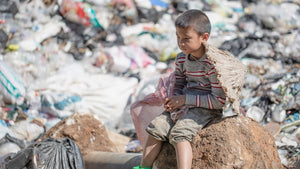Fast Fashion in the Jewelry Industry
Fast fashion is low-quality products made rapidly, in huge quantities, by mass-market retailers to appease consumers chasing ever-changing trends. Customers get clothes they like at much cheaper prices, and the businesses make lots of profit. What’s the problem with that?
The definition of fast fashion is simple, but the implications of it are numerous and complex. Fast fashion in the garment industry is creating mountains of discarded clothing and textiles. The EPA reports that millions of tons of clothing are incinerated, and millions of tons of clothing get sent to landfills. Even the bags and bags of clothing you donate often end up in the landfill.

(The mountains of discarded texile waste ends up in places like Accra, Ghana.)
The consequences of this are plentiful and all negative, but what does fast fashion in the jewelry industry look like? There’s not a lot of information on this topic, but here are some big takeaways:
Fast fashion jewelry is similar to fast fashion garments:
1. Low quality materials
2. Techniques or manufacturing that uses toxic chemicals that can leach into water, pollute the air, and impact the health of humans and wildlife.
3. Massive quantities are created, making the jewelry seem disposable which leads to folks throwing it away when it breaks or turns their skin green.
Let's start with the low-quality materials. Base metals are a common material used in fast fashion. These metals are cheaper than precious metals. They aren’t necessarily bad, but to smelt it (melt down) can be expensive and not easily done. Another issue is what the base metals are made from. When making the alloy, lead or cadmium may be used. This can contribute to metal pollution in landfills, as well as be a health concern for the person wearing the jewelry.
Plastic is used in fast fashion jewelry to keep costs down. It is often used to look like a gemstone. These aren't great for upcycling or reuse. They are prone to breaking and don't break down very fast in the landfill.
Next, is the problem with plating. Plating the base metal with gold, silver or rhodium is a common practice in fast fashion jewelry. The process to do this involves toxic chemicals that may end up in water, soil, and the air. There is also concern over the people working in the facilities and living in the surrounding communities being negatively impacted by these toxic chemicals and fumes.
Finally, mass production as a whole is detrimental. Designs have to be conducive to mass production, so originality isn’t a high priority. It just needs to be made cheaply, quickly and in large numbers. The maker is usually chasing trends, so a lot of it will only be on the shelves for a short time before being removed for the next shipment of trendy jewelry.
While there has been progress made in the working conditions of these facilities, often they are rife with workers' rights abuses: poor pay along with poor and dangerous working conditions, as well as child labor issues.

Bottom line, jewelry making will have some impact on the environment. The goal is to mitigate these impacts by being mindful of the impact to the planet and people. Using traditional methods and techniques and avoiding mass production are a great start.
Small businesses have a hard time balancing what's good for the environment with costs, growth, and keeping their customers happy. It's also challenging to design around sustainability. I avoid some jewelry making because I don't like the harmful chemicals necessary to make it nor do I want to make "disposable" jewelry, even though I make in small batches.
Some small jewelry businesses have loads of a piece made in a base metal and have it plated. This means their jewelry is cheaper than mine. I’ve watched as some businesses grow quite large with numerous brick and mortar stores, oodles of press, and celebrities wearing their jewelry. Many of my designs do not lend themselves to be mass manufactured, nor do I want to make more than I can sell. That means I can only make so much, so fast. Even if I outsourced the making, I would choose local makers and students over shipping off to some other state or country. I want to know that the people making my designs are talented craftspeople and that they are getting paid and treated well. (I think it's important that I say there have been strides made in manufacturing, and there are some companies that have much improved conditions and will work with small business that want smaller orders). There's also the fact that the plating often wears off quickly (depending on wear and tear), and I want to make things that last, or can be easily repaired.
Just as small jewelry makers grapple with these decisions, you, the consumer do the same. That's one reason I write frequently on this blog about jewelry techniques, materials, and sustainability. I want you to have plenty of information so you can make decisions that work for you when buying jewelry.
Below are a few of the other posts I've written on materials, techniques and sustainability.
Want to learn more about Base Metals?
Want to learn more about Plating?
Want to learn more about Rhodium?


